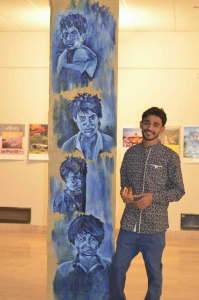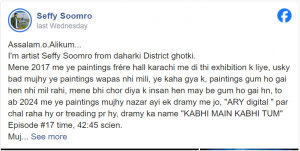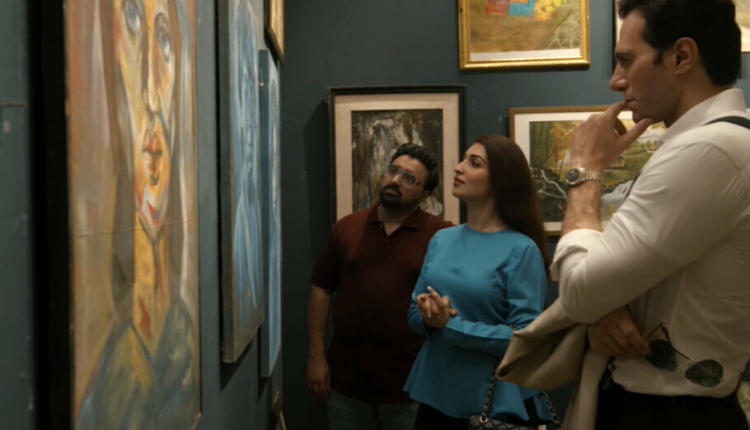When Lost Art Finds Its Way to TV Screens
An artist's long-lost painting resurfaces in a popular TV drama, sparking a debate over art theft and ethics.
Art has a way of making headlines for the most unexpected reasons. For artist Seffy Soomro, his journey with his long-lost paintings has been nothing short of a rollercoaster. What began as a hopeful submission of artwork for a 2017 exhibition at Karachi’s Frere Hall spiraled into a bitter discovery seven years later when he stumbled upon his missing paintings in a popular TV serial, Kabhi Main Kabhi Tum.
A Painful Reunion with Lost Art
In 2017, Soomro, like many other artists, submitted his work to Frere Hall, one of Karachi’s historic art venues. Little did he know that this exhibition would be the last time he’d see his artwork. After the event, he was informed by the management that his paintings, along with those of other artists, had mysteriously vanished. He was told they were “lost,” and despite his best efforts, he had to accept that his hard work was gone for good.

Fast forward to 2024. As Soomro sat down to watch Kabhi Main Kabhi Tum, a popular Pakistani drama starring Hania Aamir and Fahad Mustafa, he was hit by a wave of shock and disbelief. In episode 17, at the 22:30-minute mark, a scene showed characters admiring a painting that Soomro instantly recognized. It wasn’t just any painting—it was his own, a piece he had painstakingly created during his final year at the University of Sindh. The realization left him both elated and heartbroken.
The Facebook Outcry
Soomro’s immediate reaction was to turn to social media. His frustration, confusion, and anger were palpable as he wrote a detailed Facebook post explaining the situation. He recounted how his artwork had been submitted to Frere Hall and later declared lost. And now, after seven long years, it had resurfaced on a TV drama, without his permission or any credit.
“I was told my paintings were lost, only to see them reused without my permission,” he wrote. The tone of his post reflected his deep sense of betrayal. Not only had he lost his paintings for years, but they had also ended up being used in a commercial production without his consent, which added insult to injury.

Art Theft or Mismanagement?
The use of Soomro’s artwork in Kabhi Main Kabhi Tum has raised important questions about the handling of artwork in public galleries and entertainment productions. Who is responsible for ensuring that art is properly handled and returned to its rightful owners? Was this an isolated incident of theft, or a result of poor management at Frere Hall?
Soomro strongly believes it was fraud. He expressed that Frere Hall had committed a “clear act of dishonesty” by not returning his paintings and, potentially, selling them off to a production company or rental service. The feeling of being deceived by an institution that should protect and honor artists has left him devastated.
Big Bang Entertainment’s Response
As the controversy began to unfold on social media, it didn’t take long for the production company behind Kabhi Main Kabhi Tum, Big Bang Entertainment, to issue a statement. They distanced themselves from the situation, stating that the location for the shoot, including all props, was rented. According to the production house, they had no knowledge of where the paintings originated and advised Soomro to resolve the matter directly with the owners of Frere Hall.
“We sympathize with the artist,” read the statement, “but this is beyond our control.” Big Bang Entertainment made it clear that while they supported Soomro’s pursuit of justice, they were not involved in the sourcing of the paintings. The production team had simply filmed at the rented location, unaware of the art’s backstory.
Frere Hall Under Fire
Frere Hall, Karachi’s iconic cultural venue, found itself at the center of the controversy. The missing paintings were a significant blow to Soomro and other artists whose work had vanished under their watch. The gallery management’s lack of comment or accountability further fueled public outrage. Soomro expressed his frustration when his calls to Frere Hall went unanswered.
The missing paintings and subsequent discovery raised serious questions about the ethical practices and management of art in public galleries. Soomro, feeling deceived, expressed that his work had been not only stolen but also used for profit without any recognition or compensation.
The Role of the Media in Exposing Art Theft
One of the most fascinating aspects of this story is how media, particularly television, played an unexpected role in bringing attention to the stolen artwork. A casual evening of watching a TV serial turned into a revelation for Soomro and sparked a much-needed conversation about art ownership, ethics, and accountability. The media’s ability to amplify such incidents highlights its powerful role in shaping public perception and initiating legal investigations.
The fact that Soomro spotted his artwork in such a public manner only added to the drama surrounding the controversy. His situation resonated with many artists who have faced similar struggles in a system that often overlooks or exploits their contributions. The public’s response on social media was swift, with many expressing outrage and calling for justice.
Legal Battles and Investigations Begin
Soomro’s case caught the attention of the Sindh Cultural Minister, Syed Zulfiqar Ali Shah, who promptly formed a two-member committee to investigate the matter. The investigation was given a seven-day deadline to uncover how Soomro’s paintings had ended up in the TV serial without his permission.
Provincial officials, too, stepped in, echoing their support for the artist. “Young artists are our assets,” said a spokesperson for the culture department. “We will not tolerate injustice.”
Soomro, while hopeful that the investigation would yield positive results, remains deeply affected by the entire ordeal. “Finding it is like recovering a lost child,” he remarked in an interview. He emphasized that while the sight of his artwork on TV should have been a pleasant surprise, it instead served as a painful reminder of the injustice he had endured.
The Broader Ethical Debate in the Art World
The Soomro case has ignited a broader conversation about ethics in the art world. It’s a wake-up call for both artists and institutions alike. How can artists protect their work from theft or mishandling? What responsibilities do galleries and venues have in safeguarding art? And, crucially, what role should the entertainment industry play in ensuring they aren’t unknowingly complicit in art theft?
Art theft, whether intentional or due to negligence, erodes trust within the artistic community. Artists pour their heart and soul into their work, and to have it exploited without acknowledgment or compensation is a violation of that trust.
Art Theft and Ethical Considerations in Entertainment
This incident has also ignited discussions about the ethical responsibilities of entertainment productions when it comes to using artwork and other creative assets. While Big Bang Entertainment may not have been directly involved in the theft, the controversy has brought attention to the importance of verifying the provenance of art pieces before featuring them on screen.
Art theft is not a new issue, but the intersection of stolen art and mainstream entertainment is an eye-opener. In an industry where visual storytelling often involves showcasing unique pieces, it becomes crucial for production companies to ensure that all creative assets are obtained ethically.
This scandal has exposed the gaps in due diligence within both the art and entertainment industries. Moving forward, stricter regulations and protocols may be needed to protect artists and prevent similar incidents from occurring.
Public Reactions and Support
Soomro’s story has struck a chord with many, particularly within the art community. Social media platforms have been buzzing with discussions about the rights of artists and the responsibilities of art venues. Supporters of Soomro have voiced their outrage, calling for more stringent regulations and transparency in art exhibitions.
Many have urged Soomro to take legal action against Frere Hall, stressing that art theft is a serious offense that should not go unpunished. The question remains: How many other artists may have experienced similar situations but haven’t yet realized it?
The Emotional Toll on Artists
For artists like Seffy Soomro, their work is more than just a physical object—it’s an extension of their identity, creativity, and hard work. The emotional toll of having such personal creations stolen and mishandled is immense. In interviews, Soomro likened the rediscovery of his painting to finding a lost child, emphasizing the deep connection between an artist and their work.
Soomro’s distress over the mishandling of his paintings is understandable, especially considering that his artwork was part of his thesis, a defining milestone in his artistic journey. The loss, compounded by the unauthorized use, speaks to a larger issue faced by many artists: the lack of proper protection and respect for their intellectual property.
A Hope for Resolution
Despite the emotional toll, Soomro remains hopeful that the investigation will lead to the return of his artwork and justice for the mistreatment he’s endured. “It would have been a pleasant surprise to see my painting in a drama, but when I saw it, it reminded me of the fraud that was committed,” he shared.
As the investigation unfolds, the outcome will likely set a precedent for how similar cases are handled in the future. It’s a developing story, one that highlights the vulnerabilities artists face when their work is placed in the hands of others. For Soomro, the hope is that this controversy will not only bring him closure but also spark changes in how art is handled and protected in Pakistan.
A Defining Moment for Pakistani Art and Media
As Kabhi Main Kabhi Tum continues to air, the attention surrounding this controversy may bring lasting change to both the art world and media industry. Soomro’s persistence in seeking justice for his stolen work has opened up a crucial conversation about art theft and the ethical use of creative assets in media.
While the investigation is ongoing, one thing is clear: this is more than just a case of missing artwork. It’s a defining moment that could reshape how art is treated, protected, and respected in Pakistan. The resolution of this case will likely set a new standard for the ethical practices in the country’s entertainment industry, ensuring that artists like Soomro are not only recognized but also protected in the future.

